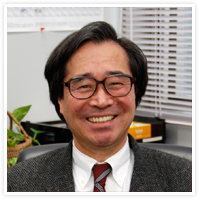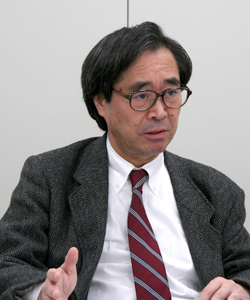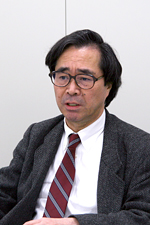Interview No.1

- Masakazu Aono
- Director-General
Interview Movie
- Although there have been some astonishing developments recently in the nanomaterials field, they have been related to only a small number of nanostructures in limited nanoscale space, noted Dr. Masakazu Aono, Director-General of the new World Premier International center for Materials Nanoarchitectonics (MANA).
-
“For practical applications, the scaling up and organic integration and mutual linkage of individual nanostructures are required. This is essential to create novel functionality in the assembly of nanostructures.”
-
 So,
he said, “a new technology system, in which we can arrange individual
nanostructures into desired arrangements, is required. We call his system
‘nanoarchitectonics.’”
So,
he said, “a new technology system, in which we can arrange individual
nanostructures into desired arrangements, is required. We call his system
‘nanoarchitectonics.’”This new field encompasses two major areas, namely “nanomaterials creation” and “nanosystems organization,” and MANA will concentrate on four key areas ? atom/molecule manipulation; chemical nanomanipulation; field-induced materials control; and controlled self-organization.
MANA was created to develop the nanoarchitectonics concept with a diverse, workforce of talented young scientists from around the world. “Materials science is characterized by variety and serendipity,” Dr. Aono said. “So we don’t want to confine our research topics to a small number of sharp research directions. I can think of at least three peaks of materials research at MANA. One is “nano-superconductors” of some kind, not necessarily the same as conventional 3-D bulk superconductors but novel superconductors at the nanoscale. The second is nanomaterials systems that can realize brain-type computers. And the third is nanoscale photo-ionic materials ? not photo-electronic, but photo-ionic materials that can eventually be used in a completely new type of solar battery.”
At MANA, researchers will deal with all kinds of materials, including macroscopic structural materials, nanoscale electronic materials, including inorganic, organic and biomaterials. “The concept of materials nanoarchitectonics is generally useful for the development of all these materials,” Dr. Aono said.
 Dr.
Aono is well qualified to lead this push into the new realm of nanoarchitectonics,
having spent almost three decades pursuing research in similar fields.
He started his own research career in surface science, but in the mid-1980s,
excited by the potential of the newly invented scanning-tunneling microscope,
he switched to nanoscience and technology. “Manipulating atoms was more
interesting than observing them,” he said. He wanted to start working
with the new technology immediately, but was busy developing and using
a powerful new technique he had invented, a method of analyzing surface
and subsurfacec atomic arrangements, which he called Collision Ion Scattering
Spectroscopy (ICISS). He later started studying atom manipulation in
1989, organizing the Aono Atomcraft Project, sponsored by the ERATO
program of the Research Development Corporation of Japan (JRDC). Since
then, he has been concentrating on nanoscience and nanotechnology research.
Dr.
Aono is well qualified to lead this push into the new realm of nanoarchitectonics,
having spent almost three decades pursuing research in similar fields.
He started his own research career in surface science, but in the mid-1980s,
excited by the potential of the newly invented scanning-tunneling microscope,
he switched to nanoscience and technology. “Manipulating atoms was more
interesting than observing them,” he said. He wanted to start working
with the new technology immediately, but was busy developing and using
a powerful new technique he had invented, a method of analyzing surface
and subsurfacec atomic arrangements, which he called Collision Ion Scattering
Spectroscopy (ICISS). He later started studying atom manipulation in
1989, organizing the Aono Atomcraft Project, sponsored by the ERATO
program of the Research Development Corporation of Japan (JRDC). Since
then, he has been concentrating on nanoscience and nanotechnology research.Dr. Aono has high hopes for the new center. “MANA is going to make major breakthroughs in materials science and technology on the basis of the concept of Materials Nanoarchitectonics. The goal is to develop new materials that can be used for the development of new technologies necessary for the sustainable development of our world. “At the same time, MANA has another important mission, to foster young scientists and research readers in materials science and technology, and supply them to the main body of NIMS, the host institute of MANA,” he said. “We hope lots of willing young scientists will join MANA from all over the world.”








